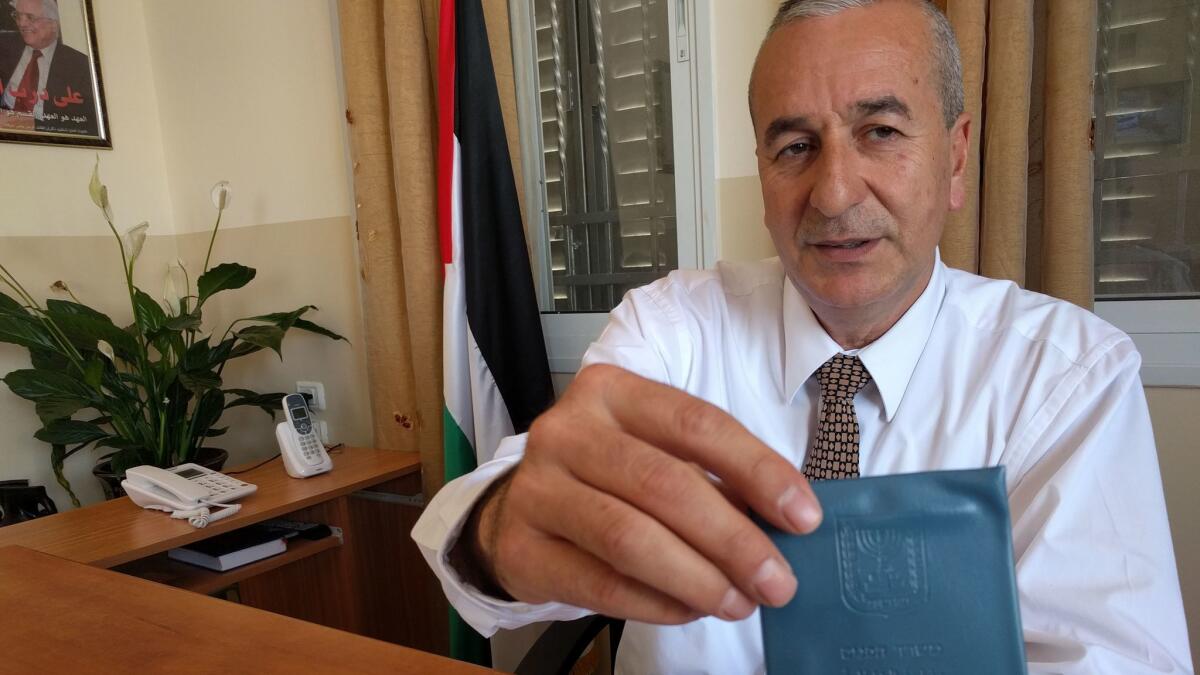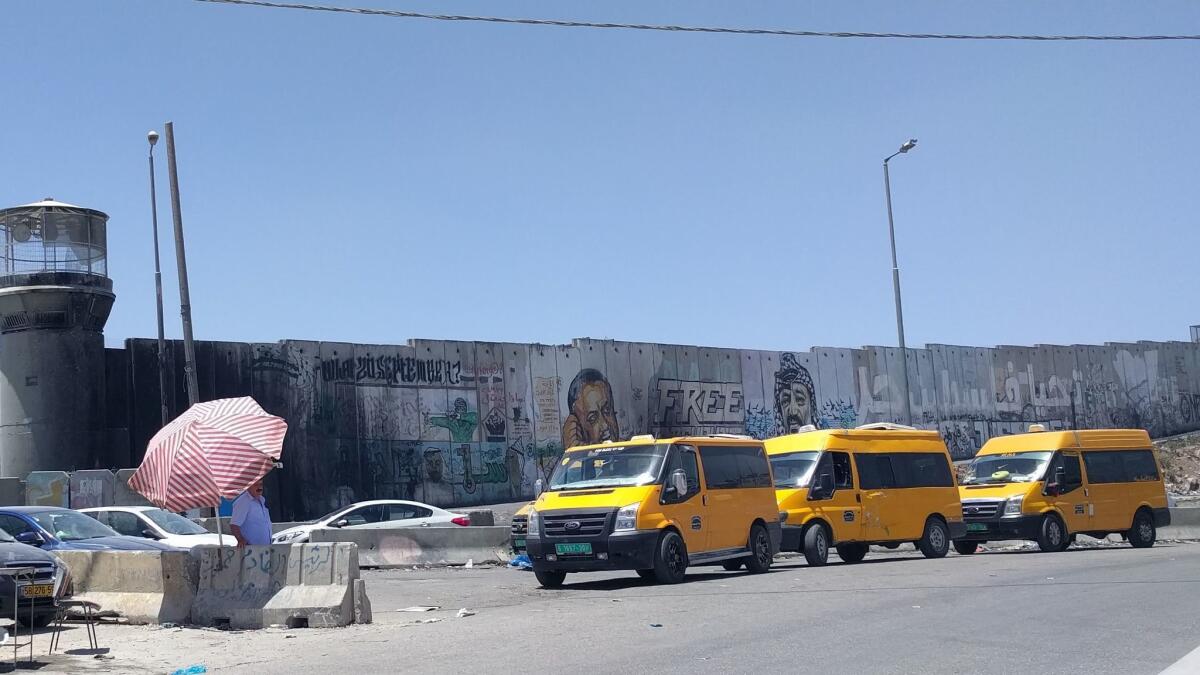A Palestinian village was annexed by Israel after the 1967 war. Now it’s behind a wall and orphaned
- Share via
Reporting from Kafr Aqab, East Jerusalem — Straddling the road from Jerusalem to Ramallah, the Palestinian neighborhood of Kafr Aqab is a confusion of illegally built apartment buildings, potholed streets lined with trash and snarled traffic.
Looming over it all are the massive concrete slabs of Israel’s separation barrier.
Immediately after conquering the West Bank during the Six-Day War, 50 years ago this month, Israel declared some of Kafr Aqab part of a “united” Jerusalem. But today the district feels abandoned by Israel to a “Twilight Zone” existence all its own.
This is a place where the police seldom come, illegal guns are plentiful and the sole post office was shut down years ago. Yet most people, including the head of the Palestinian Authority-run local council, have Israeli residency cards and dutifully pay thousands of dollars in municipal taxes to Jerusalem.
“It’s complicated,’’ said the council head, Imad Awad. “Two countries are responsible for Kafr Aqab, the Palestinians and Israel. It has two municipalities, and, unfortunately, big problems.”

When the Israelis arrived, Kafr Aqab, about three miles from the center of Ramallah and more than double that distance from Jerusalem’s Old City, was a rustic village of stone houses and olive groves with just a few hundred residents. Like the rest of the West Bank, including the eastern half of Jerusalem, it had been under Jordanian rule. The war ended that.
In the weeks after the war, part of the village was incorporated by Israel into an expanded East Jerusalem — which was annexed by the euphoric victors and declared part of their unified capital city. Kafr Aqab lies at the tip of a narrow corridor jutting northward that was gerrymandered to include an old airstrip that lies within the city limits. Part of the old village remained outside Jerusalem and lies formally within the West Bank.
Palestinian residents of Kafr Aqab and other East Jerusalem neighborhoods got Israeli blue residency cards and social welfare benefits. Most critically, they got the right to work in Israel and move about freely. Within years, Arabs from cramped neighborhoods in the center of East Jerusalem began moving to Kafr Aqab to buy larger homes at lower prices.
Over the years Kafr Aqab morphed from a village on the outskirts of Ramallah to a Jerusalem suburb.
But about 15 years ago, in the throes of a campaign of Palestinian suicide bombings, Israel built a several-hundred-mile barrier snaking around the West Bank and through East Jerusalem to keep out attackers. The Jerusalem wall physically severed the neighborhood from the city and orphaned a population estimated in the tens of thousands from most municipal services, while leaving it linked to nearby Ramallah.
Though nominally still part of Jerusalem, Kafr Aqab found itself adrift, facing a vacuum of authority. That, along with the daily trials of crossing through the West Bank’s main checkpoint to the rest of the city, underscored the uncertain political status of Palestinians as well as the difficulties of living under Israeli occupation.
“We don’t feel like we are really in Jerusalem because of the wall,’’ said Raed Hamdan, a 55-year-old resident of Kafr Aqab.
On the eve of the 1967 war, Hamdan was a 5-year-old who lived in the Christian Quarter of the Old City. His father worked for the Jordanian police. He recalled non-uniformed soldiers hiding guns in the family bathroom. Adults spoke of blood running through the alleyways down from the Damascus Gate.
When Hamdan and his family emerged from their home, Jordanian soldiers had been replaced by Israelis greeting them with the Hebrew “Shalom.”
About one year later, his family moved to Kafr Aqab. Fifty years later, he lives near Kafr Aqab’s wildcat apartment buildings and the graffiti-covered separation wall, and complains about the absence of police, Israeli or Palestinian.
“Many people have guns here,” said Hamdan. “We have no government, or rules.”
The neighborhood lacks sufficient school classrooms, ambulances or fire trucks. To reach Israeli hospitals, residents have to go through checkpoints.
The absence of any enforcement of building and planning codes has allowed the construction of a cluster of medium-rise apartment buildings just a few feet away from each other, overburdening the neighborhood’s sewage system.

Garbage collectors contracted by the Jerusalem city government pick up garbage at their whim.
The Palestinian Authority in nearby Ramallah has not moved into the vacuum, though it did establish a local council in the part of Kafr Aqab just outside of the Jerusalem border.
“Abu Mazen is making a state in Ramallah, and he doesn’t care about Kafr Aqab or Jerusalem,’’ said Jeries Tannous, 27, referring to Palestinian Authority President Mahmoud Abbas by his nickname.
At a car wash on the main road to Ramallah, young Palestinian men remembered what things were like before Israel built the wall and the looming Qalandiya checkpoint, back when trips into the heart of the city took just a few minutes instead of more than an hour.
“It was much better. There were jobs,” Tannous said. “This is a real chaos.”
The anniversary of the 1967 war, known to Palestinians as the Naqsa, or defeat, has passed with little public commemoration in the West Bank.
Saeb Erekat, the chief Palestinian peace negotiator, complained that Israel has pursued a “colonial settlement strategy” aimed at taking Palestinian land over the last 50 years.
“For the Palestinian people, marking 50 years of occupation means marking 50 years of oppression, subjugation and daily control over all aspects of people’s lives,” Erekat said in an English statement. “It means 50 years of attacks and aggression from occupation forces and settlers against a defenseless civilian population. At the same time, it has also meant 50 years of statements and international resolutions that Israel, the occupying power, has insisted on violating with impunity.”
Israel, by contrast, has marked the anniversary of its victory with a month of official celebrations, academic conferences and media coverage, including tributes to Jerusalem and its Jewish holy places. Israeli leaders vow that the city will forever remain their “undivided” capital, but Palestinians insist that East Jerusalem will be the capital of their future state.
Daniel Seidemann, an Israeli peace activist and expert on Jerusalem, said Israeli talk of a united Jerusalem is belied by the disarray in places such as Kafr Aqab.
“The fate of these people was decided by an Israeli whim in the week or two after the ’67 war, when, completely and totally unprepared, we decided to annex not only East Jerusalem, but its environs. That dictate determines the fate of tens of thousands of residents to this day,’’ he said.
“Kafr Aqab is the quintessential expression of the hollowness of [the] Israeli fiction of the undivided city of Jerusalem. We annexed them by mistake. We never really wanted them. … We won’t recognize the total failure of this fiction, so we condemn these people to live in limbo.”
A spokeswoman for the Jerusalem municipality didn’t respond to requests for comment. The signs of an Israeli government presence are few and far between. Along the Ramallah-Jerusalem road, a small placard in Hebrew with Jerusalem’s Lion of Judah municipal insignia marks an Israeli-funded school.
In recent months, blue and white street signs in Hebrew, Arabic and English have gone up, giving residents a proper address for the first time. As the signs have gone up, however, there have been reports in Israeli newspapers that the government is considering redrawing Jerusalem’s borders to cede Kafr Aqab and other Jerusalem neighborhoods beyond the separation barrier. Other reports have suggested there are plans for a new Israeli neighborhood just over the wall, where the old airstrip is located.
Obeideh Said, a 47-year-old teacher whose mother was forced out of the Jewish Quarter of Jerusalem’s Old City in the months after the 1967 war, looked out from her apartment over Kafr Aqab’s jagged concrete wall to the old airstrip.
“Unfortunately, we hear there is going to be a settlement there, and this fills us with agony,” she said. “Look at my neighborhood: there’s garbage, there’s lack of urban planning, and it’s the peak of disorganization and unhappiness.”
For now, it seems, the schoolteacher and most of the neighborhood residents are waiting for Israel to come back to the place it claimed half a century ago.
ALSO
Israel takes steps to define itself as a Jewish state and demote the status of the Arabic language
Arab nations cut ties to Qatar, deepening rift in Persian Gulf
Israel’s government angers Palestinians by meeting near Jerusalem holy site
Mitnick is a special correspondent.
ALSO
Melania Trump and Sara Netanyahu agree: the media is unfair to our husbands
Israel acknowledges ‘pinpoint’ change needed after Trump intelligence disclosure
More to Read
Sign up for Essential California
The most important California stories and recommendations in your inbox every morning.
You may occasionally receive promotional content from the Los Angeles Times.










